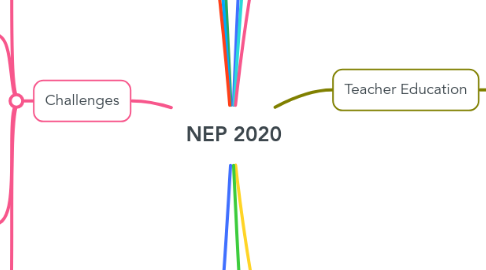
1. Merits of NEP2020
1.1. Holistic development
1.1.1. Well-rounded individuals
1.2. Experiential learning
1.2.1. Apply knowledge in real life situations
1.3. Flexible pathways
1.3.1. To pursue diverse career paths
1.4. Teacher Empowerment
1.5. Aims to eliminate problems of pedgagogy, structural inequalities
2. Foundational objectives
2.1. Multidisciplinary Education
2.2. ECCE
2.2.1. Lifelong learning
2.3. Structure
2.3.1. 5(Foundational)+3(Preparatory)+3(Middle)+4(Secondary stage)
3. Vision
3.1. Enhancement of the Indian education system for holistic development.
4. Challenges
4.1. Curriculum
4.1.1. Balancing local and global prespectives
4.1.2. Integrating multidisciplinary and experiential learning
4.1.3. Updating textbooks and learning materials
4.2. Pedagogy
4.2.1. Training teacher for new methods and skills
4.2.2. Promoting critical thinking and creativity
4.2.3. Ensuring equity and inclusion
4.3. Governance
4.3.1. Increasing public investment and accountability
4.3.2. Enhancing autonomy and collaboration
4.3.3. Resolving regulatory and policy issues
4.4. Assessment
4.4.1. Developing reliable and valid assessment tools
4.4.2. Shifting from rote learning to holistic development
5. Principles
5.1. Equiry and Inclusion
5.2. Respect for diversity and local context to be reflected in curriculum, pedagogy and policy
5.3. Emphasize conceptual understanding not rote learning
5.4. Critical thinking and creativity
5.5. Continuous review
5.6. Unique capabilities
6. Objectives
6.1. To reimagine and revitalize education system
6.2. To promote a flexible and multidisciplinay approach
6.3. To empower Educators
6.4. To prepare learners for the challenges of the 21st century
7. Other key areas
7.1. Language, arts and culture
7.1.1. Mother tongue as a medium of instruction
7.1.2. Promotion of Indian languages
7.1.3. Cultural Integration
7.2. Adult Education
8. Teacher Education
8.1. Continuous Professional development
8.1.1. Teacher training programs
8.1.2. Skill Enhancement
8.2. Standard-setting and Accreditation
8.2.1. Quality Assurance
8.2.2. Accreditation mechanism
8.3. Technology integration in Teaching
8.3.1. Digital teaching tools
8.3.2. Online Training
8.4. A New NCFTE 2021 by NCTE in consulttaion with NCERT
9. Regulatory Framework
9.1. National Education commission
9.1.1. Policy Formulation
9.1.2. Strategic Planning
9.2. Higher Education Commission of India(HECI)
9.2.1. Regulatory body for higher education
9.2.1.1. NHERC
9.2.2. Accreditation and Funding
9.3. General Education council (GEC)
9.3.1. NHEQF to be formulated in sync with NSQF
9.3.1.1. (PSSBs)
9.4. National Accreditation Council(NAAC)
9.4.1. Quality Assurance
9.4.2. Accreditation Standards
10. School Education
10.1. Curriculum and Pedagogy
10.1.1. Focus on critical thinking
10.1.2. Reduce content load
10.2. Assessment Reforms
10.2.1. Formative and summative assessment
10.2.2. Reducing exam pressure
10.3. State school standards authority(SSSA)
10.3.1. For standard setting and accountability
10.4. Vocational Education
10.4.1. Skill Development
10.4.2. Practical learning
10.5. Integration of Technology
10.5.1. Digital learning
10.5.2. e-learning platforms
10.6. Gross Enrollment Ratio to increase 100 % by 2030
11. Higher Education
11.1. Holistic Multidisciplinary Education
11.1.1. Flexibility in Course Selection
11.1.2. Interdisciplinary Studies(MERUs)
11.2. Autonomy & Academic Freedom
11.2.1. Accreditation reforms
11.2.2. Empowering Institutions
11.3. Research and Innovation
11.3.1. National Research foundation
11.3.2. Promoting Research culture
11.4. Technology $ Foreign institutes
11.4.1. National Education Technology Forum(NETF)
11.4.2. National Assessment Centre-'PARAKH"
11.5. Gross enrollment Ratio to be raised by 50% by 2035
11.6. Common Entrance Exam
11.6.1. For all higher education institutes by NTA
